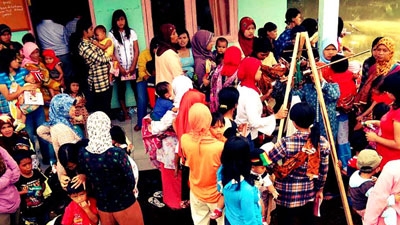Overview
PNPM Generasi is an innovative Government of Indonesia social assistance program designed to address three lagging Millennium Development Goals: Maternal Health, Child Health, and Universal Education.
Challenge
Although Indonesia has made strides in key human development indicators, including near universal primary school enrollment for boys and girls and a rapidly declining child mortality rate, other indicators remain higher than most countries in the region. These indicators include infant and maternal mortality, child malnutrition, junior secondary school enrollment, school transition rates and learning outcomes. In addition, there are substantial geographical disparities in these outcomes, with poorer outcomes in rural and remote provinces and districts.
Approach
PNPM Generasi is an incentivized community block grant program that builds on the architecture of the GOI’s community driven development program, the National Community Empowerment Program in Rural Areas (PNPM-Rural). The program uses a facilitated community decision-making process to allocate block grant funds to target 12 health and education indicators. Communities work with facilitators and health and education service providers to improve access to and use of health and education services. Average block grants total approximately IDR110,000,000 village/year (approximately US$12,000 village/year). To give communities incentives to focus on the most effective polities to target program indicators, the GOI determines the size of the village's PNPM Generasi block grant for the subsequent year partly on the village's performance on each of the 12 targeted health and education indicators.
The flexibility of this approach helps address the strong regional disparities seen in health and educational attainment across Indonesia. The current estimated beneficiary total is 3,630,818 (approximately 1,835,100 of whom are women).
The 12 PNPM Generasi Indicators
Health
- Four prenatal care visits for pregnant women
- Taking iron tablets during pregnancy
- Delivery assisted by a trained professional
- Two postnatal care visits
- Complete childhood immunizations
- Adequate monthly weight increases for infants
- Monthly weighing for children under 3 and biannually for children under 5
- Vitamin A twice a year for children under 5
Education
- Primary school enrollment of children 7 to 12 years old
- Minimum attendance rate of 85 percent for primary school-aged children
- Junior secondary school enrollment of children 13-15 years old
- Minimum attendance rate of 85 percent for junior secondary school-aged children
Project Locations
PNPM Generasi is currently active in 8 provinces, 290 kecamatan, and 2892 villages.
In 2007, PNPM Generasi began in five provinces: West Java, East Java, North Sulawesi, Gorontalo, and East Nusa Tenggara. In 2010, the program expanded into West Nusa Tenggara to target high levels of malnutrition and severe malnutrition.
In 2012, PNPM Generasi expanded into Maluku and West Sulawesi, two provinces with high infant and under-five mortality; high levels of malnutrition and severe malnutrition; low levels of birthing with trained midwives; and low levels of middle-school enrollment and attendance.
Results
PNPM Generasi has had three waves of evaluation, including a Baseline Survey (2007) and Mid-Term Impact Evaluation (2009), and Final Impact Evaluation (2011). To allow for a rigorous evaluation of PNPM Generasi, the Government of Indonesia incorporated random assignment into the selection of program locations. Within the districts selected for the program, entire kecamatan were randomly allocated to either receive PNPM Generasi or to be in the control group. This series of evaluations represents one of the largest randomized social experiments conducted in the world to date.
Over the life of the program PNPM Generasi has:
- Enabled over 1.6 million women and children to receive nutrition counseling and support;
- Assisted over 1 million children under the age of 5 to obtain Vitamin A supplements;
- Ensured that over 770,000 pregnant women receive iron supplements;
- Helped over 365,000 children receive immunizations;
- Eliminated over 185,000 cases of underweight children;
- Provided training and operational support to over 59,000 community health volunteers;
- Enabled 556,000 poor primary and junior secondary students to obtain textbooks;
- Provided assistance to approximately 382,000 poor primary and junior secondary students in the form of scholarships, transportation money, and uniforms; and
- Engaged women in basic health and education service planning and decision-making processes—on average 67 percent of participants in program socialization, planning, and monitoring meetings were women.
Bank Contribution
PNPM Generasi is funded through a combination of funds from the Government of Indonesia and members of the World Bank administered multi-donor PNPM Support Facility.
Government of Indonesia contributions since 2010 are:
- 2010: US$22,152,777.80
- 2011: US$15,000,000.00
- 2012: US$44,280,555.60
PNPM Support Facility grant:
- 2010: US$10.2 million, which funded the expansion into one new province, West Nusa Tenggara (NTB)
- 2011-2012: US$ 28.1 million, which funded another expansion within existing provinces as well into two new provinces, North Maluku and West Sulawesi.
Partners
In addition to Bappenas, the Coordinating Ministry for People’s Welfare, and The Ministry of Finance, members of the PNPM Support Facility Joint Management Committee are:
AusAid, Danida, the United Kingdom Department for International Development (DFID), the Embassy of the Netherlands, the European Union, USAID, and the World Bank.
Toward the Future
PNPM Generasi is building on lessons learned from implementation and the three-wave evaluation. Moving forward, the program will work to improve specific maternal health and child development outcomes, including malnutrition, stunting, and early childhood development.


